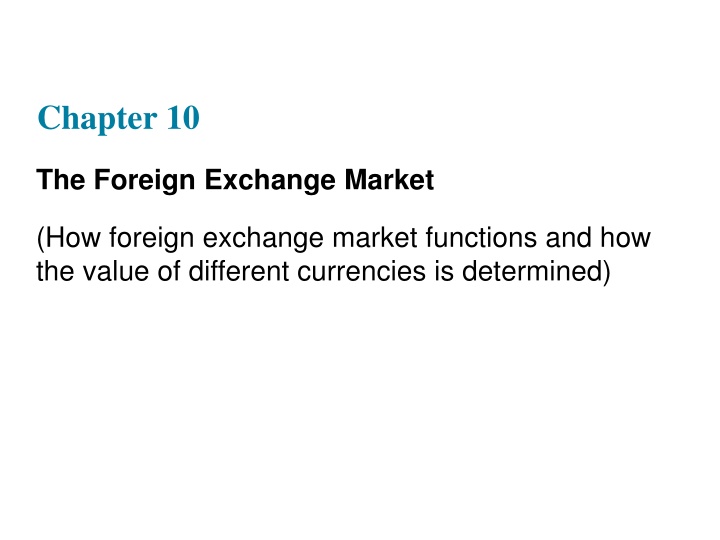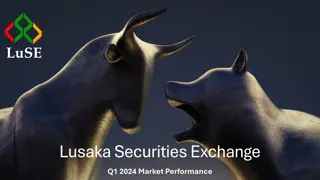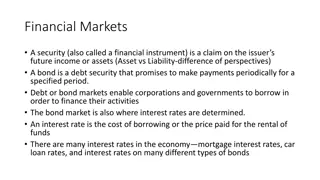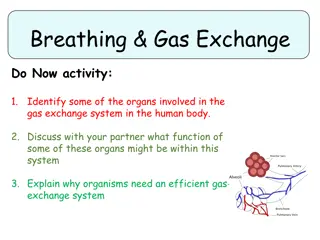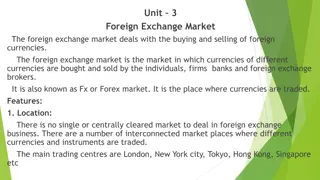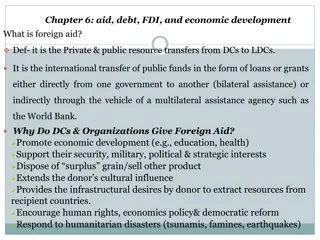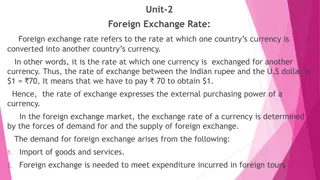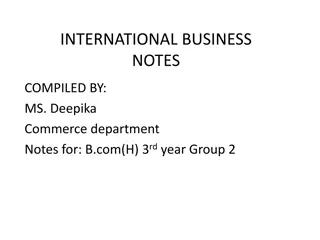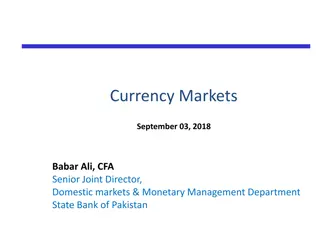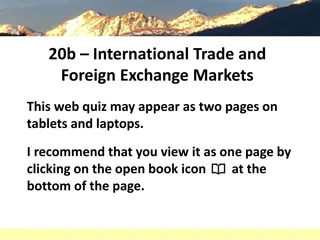Foreign Exchange Market Essentials
Explore the workings of the foreign exchange market and the factors influencing exchange rates. Understand the significance of exchange rates and how they impact economies in the short and long run. Gain insights into the dynamics of currency value determination and the implications for international trade.
Download Presentation

Please find below an Image/Link to download the presentation.
The content on the website is provided AS IS for your information and personal use only. It may not be sold, licensed, or shared on other websites without obtaining consent from the author.If you encounter any issues during the download, it is possible that the publisher has removed the file from their server.
You are allowed to download the files provided on this website for personal or commercial use, subject to the condition that they are used lawfully. All files are the property of their respective owners.
The content on the website is provided AS IS for your information and personal use only. It may not be sold, licensed, or shared on other websites without obtaining consent from the author.
E N D
Presentation Transcript
Chapter 10 The Foreign Exchange Market (How foreign exchange market functions and how the value of different currencies is determined)
Learning Objectives Explain how the foreign exchange market works and why exchange rates are importance. Identify the main factors that affect exchange rates in the long run. Draw the demand and supply curves for foreign exchange market and interpret the equilibrium in the market for foreign exchange. List and illustrate the factors that affect the exchange rates in the short run.
Foreign Exchange Market (1 of 2) Exchange rate: price of one currency in terms of another Foreign exchange market: the financial market where exchange rates are determined Spot transaction: immediate (two-day) exchange of bank deposits Spot exchange rate Forward transaction: the exchange of bank deposits at some specified future date Forward exchange rate
Foreign Exchange Market (2 of 2) Appreciation: a currency rises in value relative to another currency Depreciation: a currency falls in value relative to another currency When a country s currency appreciates, the country s goods become more expensive to foreigners and foreign goods in that country become less expensive to domestic economic agents. Over-the-counter market mainly banks
Exchange Rates in the Long Run Law of one price: the prices of an identical good should be the same throughout the world if trade barriers are low Theory of Purchasing Power Parity assumptions: All goods are identical in both countries Trade barriers and transportation costs are low Many goods and services are not traded across borders
Exchange Rate of PKR to USD Source: https://www.ceicdata.com/en/indicator/pakistan/exchange-rate-against-usd
Factors That Affect Exchange Rates in the Long Run The basic rule: Anything that increases the demand for domestically produced goods relative to foreign traded goods tends to appreciates domestic currency Relative price levels Trade barriers Preferences for domestic versus foreign goods Productivity
Summary Table 1 Factors That Affect Exchange Rates in the Long Run Factor Change in Factor Response of the Exchange Rate, E* Domestic price level Trade barriers Import demand Export demand Productivity *Units of foreign currency per dollar: indicates domestic currency appreciation; , depreciation. Relative to other countries. Note: Only increases ( ) in the factors are shown; the effects of decreases in the variables on the exchange rate are the opposite of those indicated in the Response column.
Exchange Rates in the Short Run: A Supply and Demand Analysis An exchange rate is the price of domestic (dollar) assets in terms of foreign assets Supply curve for domestic assets Assume amount of domestic assets is fixed (supply curve is vertical) Demand curve for domestic assets Most important determinant is the relative expected return of domestic assets At lower current values of the dollar (everything else equal), the quantity demanded of dollar assets is higher
Figure 2 Equilibrium in the Foreign Exchange Market
Explaining Changes in Exchange Rates Shifts in the demand for domestic assets Domestic interest rate Foreign interest rate Expected future exchange rate
Figure 3 Response to an Increase in the Domestic Interest Rate, iD
Figure 4 Response to an Increase in the Foreign Interest Rate, iF
Figure 5 Response to an Increase in the Expected Future Exchange Rate, Eet+1
Summary Table 2 Factors That Shift the Demand Curve for Domestic Assets and Affect the Exchange Rate
Application: Effects of Changes in Interest Rates on the Equilibrium Exchange Rate Changes in Interest Rates When domestic real interest rates raise, the domestic currency appreciates. When domestic interest rates rise due to an expected increase in inflation, the domestic currency depreciates. Changes in the Money Supply A higher domestic money supply causes the domestic currency to depreciate.
Figure 6 Effect of a Rise in the Domestic Interest Rate As a Result of an Increase in Expected Inflation
